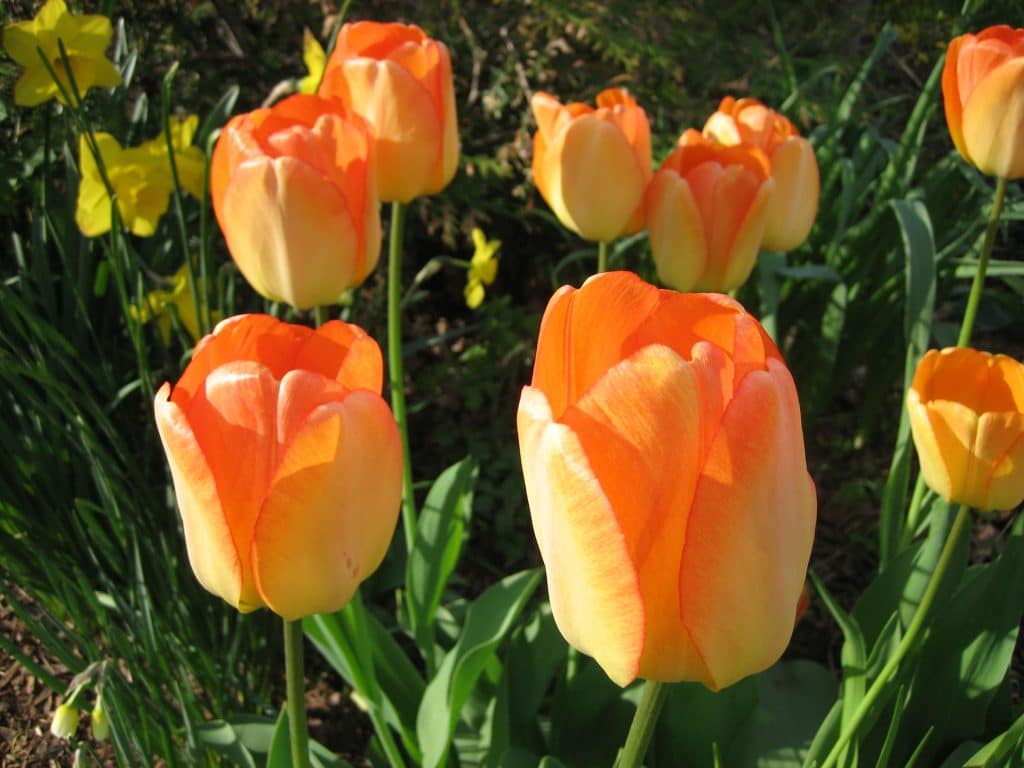
When we moved to our current house in 1984, it was late May and there was a cluster of red tulips blooming in the front garden under a birch tree. Fast forward a few decades, and the birch tree is gone (struck by lightning, and subsequently removed), and the same red tulips are still blooming. I think these must be Darwin tulips, the longest-lasting tulip bulbs I know. When planted in a bright location, they’ll reliably return for many years, and perhaps indefinitely, based on my own clump that bloomed again this spring. These Darwin tulips reside under a section of the lawn that receives half a day of sun and turfgrass fertilizer in late spring, and is somewhat dry in summer. The moist conditions in spring and benign neglect in summer seem to favour their longevity.
All tulip bulbs have the ability to continue flowering for at least three years, given the right cultural conditions. Tulips need a robust period of growth in spring, with a half day or more of sunlight, consistent soil moisture and fertilizing after their flowers drop to store up energy in the bulb for next year’s flower. When the foliage has finished ripening and can be removed, tulip bulbs need a period of dry summer dormancy. This summer rest is followed by autumn root activity, when moisture is absorbed to maintain the bulb tissues through winter dormancy.
Tulip bulbs that have fewer or smaller flowers in their second year, and increasingly broad foliage and no flowers in their third and fourth years, are probably short on energy necessary to form flower buds. A spring fertilizer feeding can solve that problem. When tulips dwindle, sending up only a thin leaf or two, the problem may be their location. Tulips planted in perennial beds are likely being irrigated through the growing season, and missing their summer dry dormancy. If you dig up the bulbs and find them rotting, poor drainage or excessive irrigation may have contributed to their demise. Planting in somewhat drier locations, such as near hedges, between flowering shrubs or as companions to specimen conifers, will possibly give them less summer moisture and keep them blooming for several years.
Given my experience with the inherited red Darwin tulips, and other Darwins I’ve planted, I’ve found that they seem to be less demanding and more resilient than most. I don’t know the name of my red tulips, though I suspect they’re ‘Appledorn’. Two of my favourite Darwin tulips are ‘Ivory Floradale’, which starts out butter yellow and fades to cream, and ‘Daydream’, which emerges lemon yellow and turns to rich pink-orange. An interesting new cultivar catching my eye is ‘First Cherry Blossom’, with white petals that are heavily bordered and tipped in cherry pink.
Fortunately, there are long lists of Darwin hybrid tulips in all colours, and there’s certain to be something for every colour scheme. Darwins are generally 20 to 24 inches (50 to 60 cm) tall and bloom in mid-May.
Species tulips also return reliably for several years when planted in the usual good circumstances. If you’ve ever grown the sunny yellow-and-white Tulipa tarda, six inches (15 cm) tall, you know it’s with you forever. Other worthwhile and lasting species are T. saxatilis six inches (15 cm) tall, which has deep fuchsia petals with a golden yellow centre blotch (this species is stoloniferous and will naturalize); and T. batalinii, six inches (15 cm), with soft yellow flowers opening in direct sunlight (they won’t open on a cloudy day).
These species have smaller bulbs than the larger Darwin hybrid tulips, and should be planted in well-drained, even gritty, soil about six inches (15 cm) deep. Removing seedheads as they form preserves the bulbs’ energy for next year’s flowers, and a bit of granular fertilizer given as their foliage ripens won’t go amiss.

